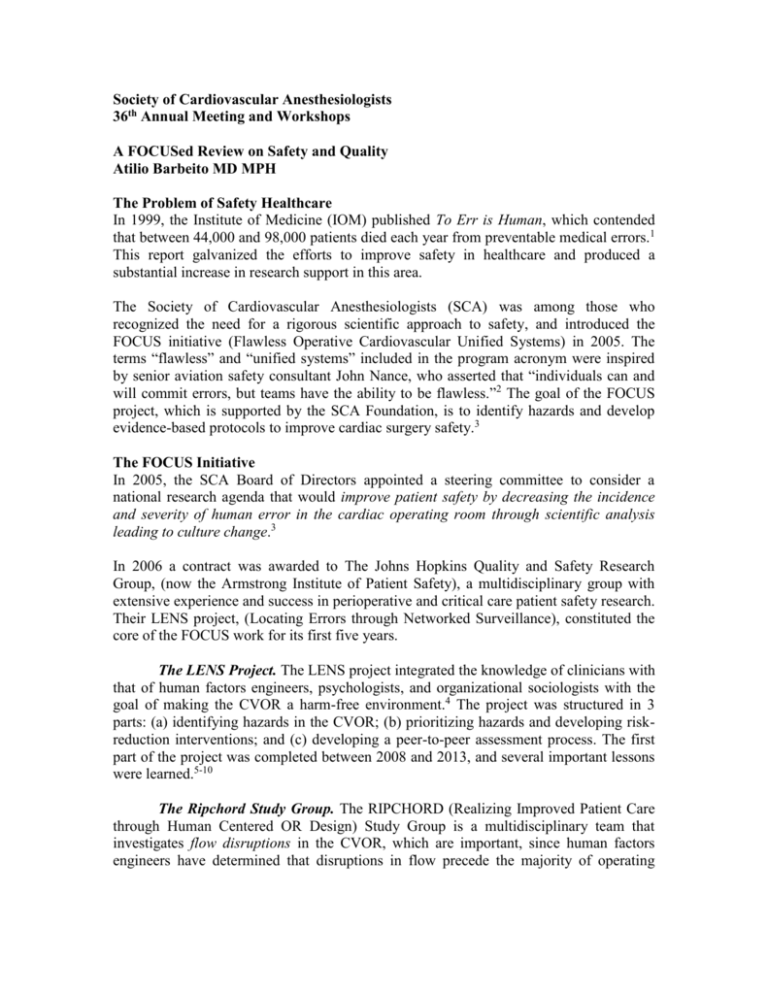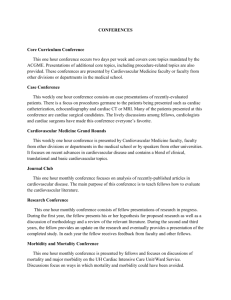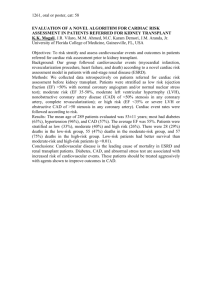A FOCUSed Review of Quality and Safety
advertisement

Society of Cardiovascular Anesthesiologists 36th Annual Meeting and Workshops A FOCUSed Review on Safety and Quality Atilio Barbeito MD MPH The Problem of Safety Healthcare In 1999, the Institute of Medicine (IOM) published To Err is Human, which contended that between 44,000 and 98,000 patients died each year from preventable medical errors.1 This report galvanized the efforts to improve safety in healthcare and produced a substantial increase in research support in this area. The Society of Cardiovascular Anesthesiologists (SCA) was among those who recognized the need for a rigorous scientific approach to safety, and introduced the FOCUS initiative (Flawless Operative Cardiovascular Unified Systems) in 2005. The terms “flawless” and “unified systems” included in the program acronym were inspired by senior aviation safety consultant John Nance, who asserted that “individuals can and will commit errors, but teams have the ability to be flawless.”2 The goal of the FOCUS project, which is supported by the SCA Foundation, is to identify hazards and develop evidence-based protocols to improve cardiac surgery safety.3 The FOCUS Initiative In 2005, the SCA Board of Directors appointed a steering committee to consider a national research agenda that would improve patient safety by decreasing the incidence and severity of human error in the cardiac operating room through scientific analysis leading to culture change.3 In 2006 a contract was awarded to The Johns Hopkins Quality and Safety Research Group, (now the Armstrong Institute of Patient Safety), a multidisciplinary group with extensive experience and success in perioperative and critical care patient safety research. Their LENS project, (Locating Errors through Networked Surveillance), constituted the core of the FOCUS work for its first five years. The LENS Project. The LENS project integrated the knowledge of clinicians with that of human factors engineers, psychologists, and organizational sociologists with the goal of making the CVOR a harm-free environment.4 The project was structured in 3 parts: (a) identifying hazards in the CVOR; (b) prioritizing hazards and developing riskreduction interventions; and (c) developing a peer-to-peer assessment process. The first part of the project was completed between 2008 and 2013, and several important lessons were learned.5-10 The Ripchord Study Group. The RIPCHORD (Realizing Improved Patient Care through Human Centered OR Design) Study Group is a multidisciplinary team that investigates flow disruptions in the CVOR, which are important, since human factors engineers have determined that disruptions in flow precede the majority of operating room errors. This group has been part of the FOCUS initiative and has made important contributions to our understanding of errors in the CVOR.11 Lessons Learned The knowledge gained from the FOCUS and Ripchord projects has been summarized in 10 peer-reviewed manuscripts published over the past five years. The work done under the umbrella of FOCUS has identified many good practices in the CVOR as well as several hazards and defects, which could be summarized in the following 5 categories: Provider-provider interactions, such as poor teamwork and communication Provider-patient interactions, such as failure to provide evidence-based care Provider- technology interactions, such as equipment design problems Provider-physical space interactions, such as poor OR layout and design Provider-institution interactions, such as production pressure The SCA’s rigorous approach to understanding hazards in the CVOR has been lauded as “the next phase in [the] evolution of understanding through direct observation and analysis of work processes.”12 Importantly, the need to improve safety in the CVOR has forced us to look carefully at our systems of care, and we are slowly realizing that safety, although a laudable goal, is a partial one. Large variations in practice, not adhering to guidelines and best practices, providing care that does not add value, failure to provide care in a timely manner, focusing on outcomes that do not matter to patients, neglecting certain patient populations; these problems occur all too commonly throughout our CVORs and cost thousands of lives and dollars every year, and solving them is an imperative. As is happening with rest of the ‘safety movement’, the FOCUS initiative may evolve into a bolder, more comprehensive endeavor. Although it is easier for the general public to make the leap from one tragic story appearing in the lay press to the staggering safety statistics often cited,1 our system is plagued with problems of effectiveness, efficiency, equity, patient-centeredness, and timeliness that also need to be addressed.13 Targeting these issues will not draw the same public interest as pursuing the elimination of the “accidental death”, but this is where the scientific evidence is leading us. With this broader and more encompassing goal of improving quality beyond patient safety we will not know exactly whose lives are saved, but there will be more of them.14 References 1. Committee on Quality of Health Care in America IoM. To Err Is Human: Building a Safer Health System. Washington, DC2000. 2. Spiess BD. Human error in medicine: change in cardiac operating rooms through the FOCUS initiative. J. Extra. Corpor. Technol. Mar 2011;43(1):P33-38. 3. Spiess BD, Wahr JA, Nussmeier NA. Bring your life into FOCUS! Anesth. Analg. Feb 1 2010;110(2):283-287. 4. Martinez EA, Marsteller JA, Thompson DA, et al. The Society of Cardiovascular Anesthesiologists' FOCUS initiative: Locating Errors through Networked Surveillance (LENS) project vision. Anesth. Analg. Feb 1 2010;110(2):307-311. 5. 6. 7. 8. 9. 10. 11. 12. 13. 14. Martinez EA, Shore A, Colantuoni E, et al. Cardiac surgery errors: results from the UK National Reporting and Learning System. Int. J. Qual. Health Care. May 5 2011. Martinez EA, Thompson DA, Errett NA, et al. Review article: high stakes and high risk: a focused qualitative review of hazards during cardiac surgery. Anesth. Analg. May 2011;112(5):1061-1074. Gurses AP, Kim G, Martinez EA, et al. Identifying and categorising patient safety hazards in cardiovascular operating rooms using an interdisciplinary approach: a multisite study. BMJ quality & safety. Oct 2012;21(10):810-818. Thompson DA, Kass N, Holzmueller C, et al. Variation in local institutional review board evaluations of a multicenter patient safety study. J. Healthc. Qual. Jul-Aug 2012;34(4):33-39. Gurses AP, Martinez EA, Bauer L, et al. Using human factors engineering to improve patient safety in the cardiovascular operating room. Work. 2012;41 Suppl 1:1801-1804. Pennathur PR, Thompson D, Abernathy JH, 3rd, et al. Technologies in the wild (TiW): human factors implications for patient safety in the cardiovascular operating room. Ergonomics. 2013;56(2):205-219. Palmer G, 2nd, Abernathy JH, 3rd, Swinton G, et al. Realizing Improved Patient Care through Human-centered Operating Room Design: A Human Factors Methodology for Observing Flow Disruptions in the Cardiothoracic Operating Room. Anesthesiology. Jun 27 2013. Catchpole K, Wiegmann D. Understanding safety and performance in the cardiac operating room: from 'sharp end' to 'blunt end'. BMJ quality & safety. Oct 2012;21(10):807-809. Woolf SH. Patient safety is not enough: targeting quality improvements to optimize the health of the population. Ann. Intern. Med. Jan 6 2004;140(1):33-36. Brennan TA, Gawande A, Thomas E, Studdert D. Accidental deaths, saved lives, and improved quality. N. Engl. J. Med. Sep 29 2005;353(13):1405-1409.









